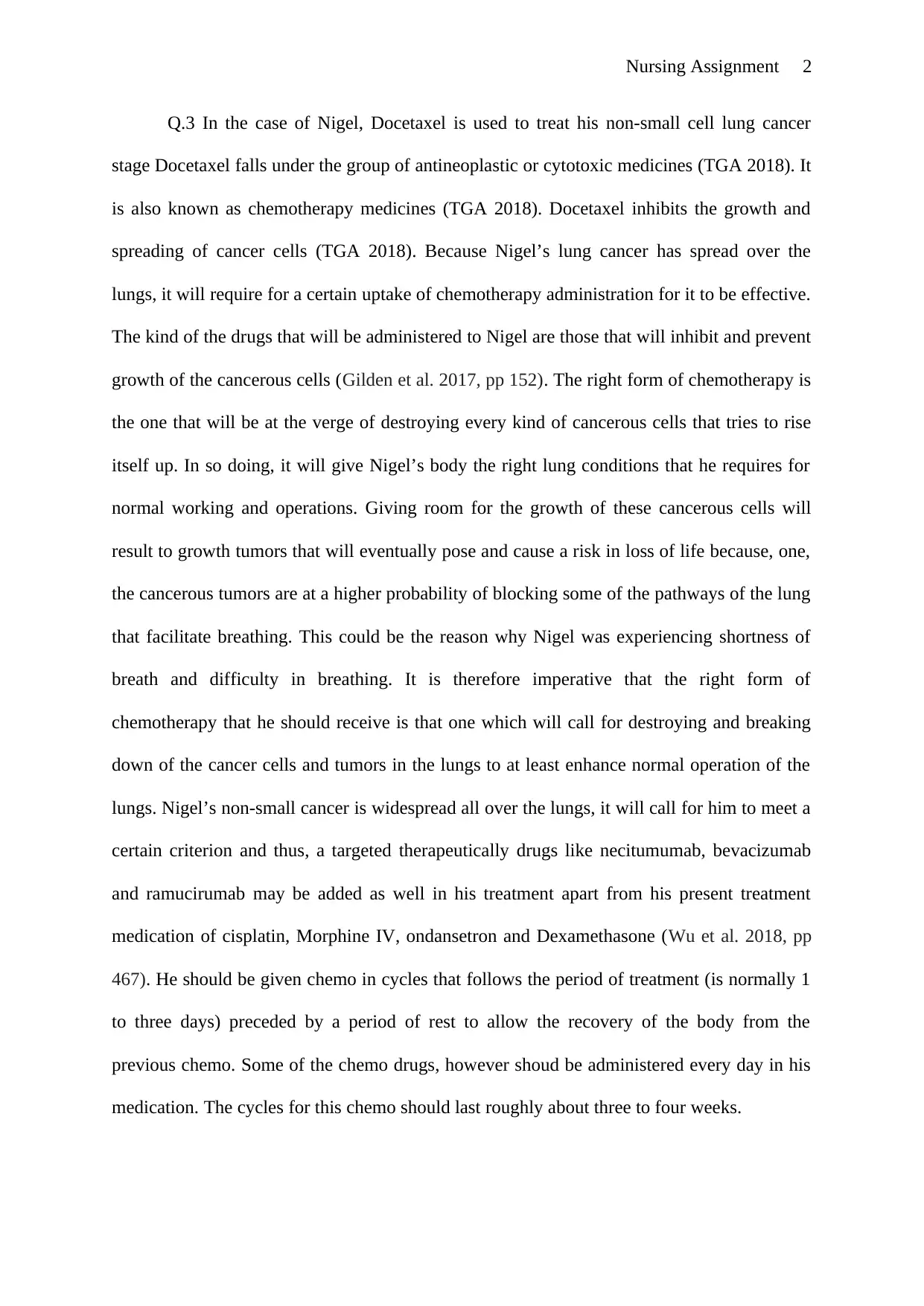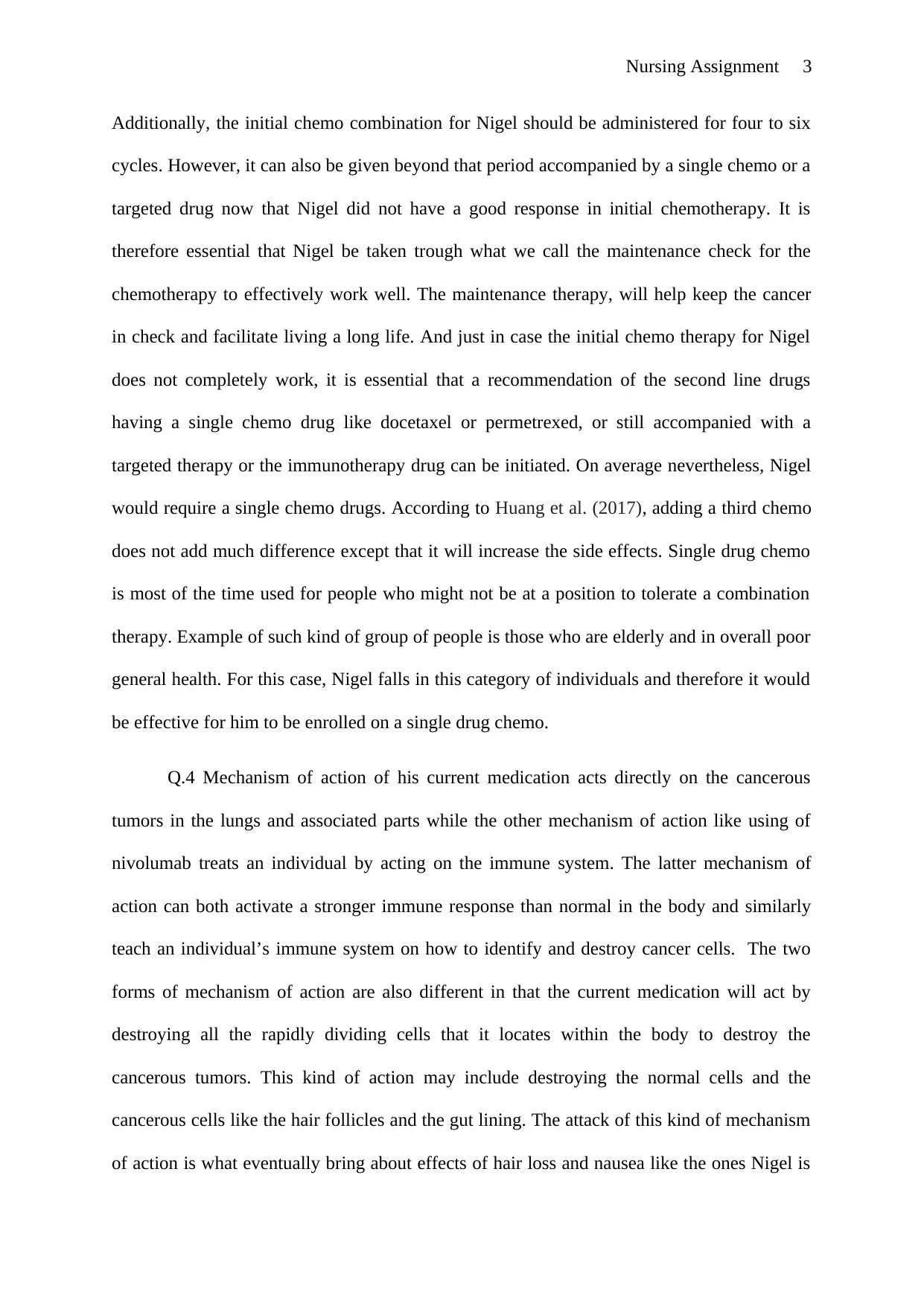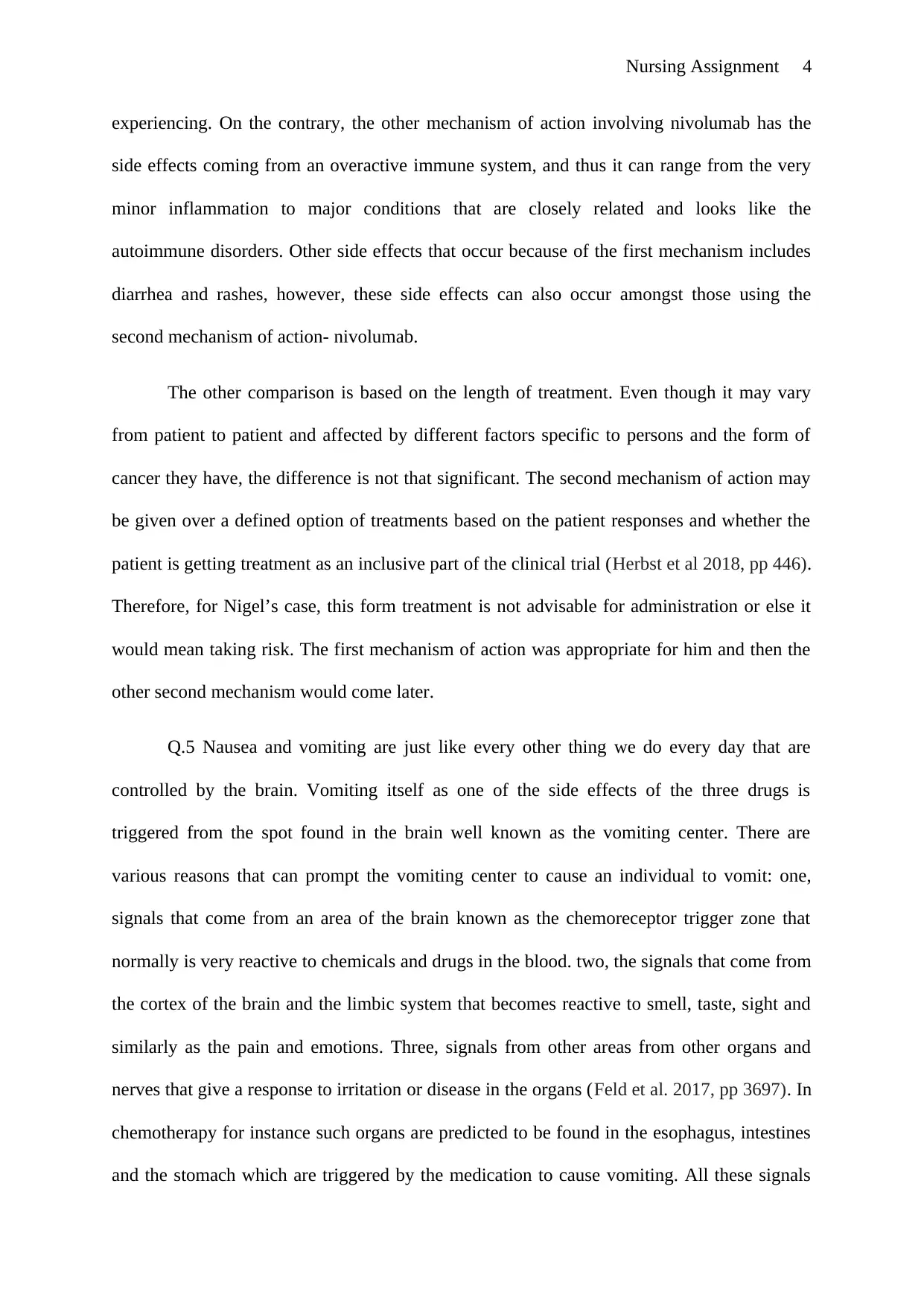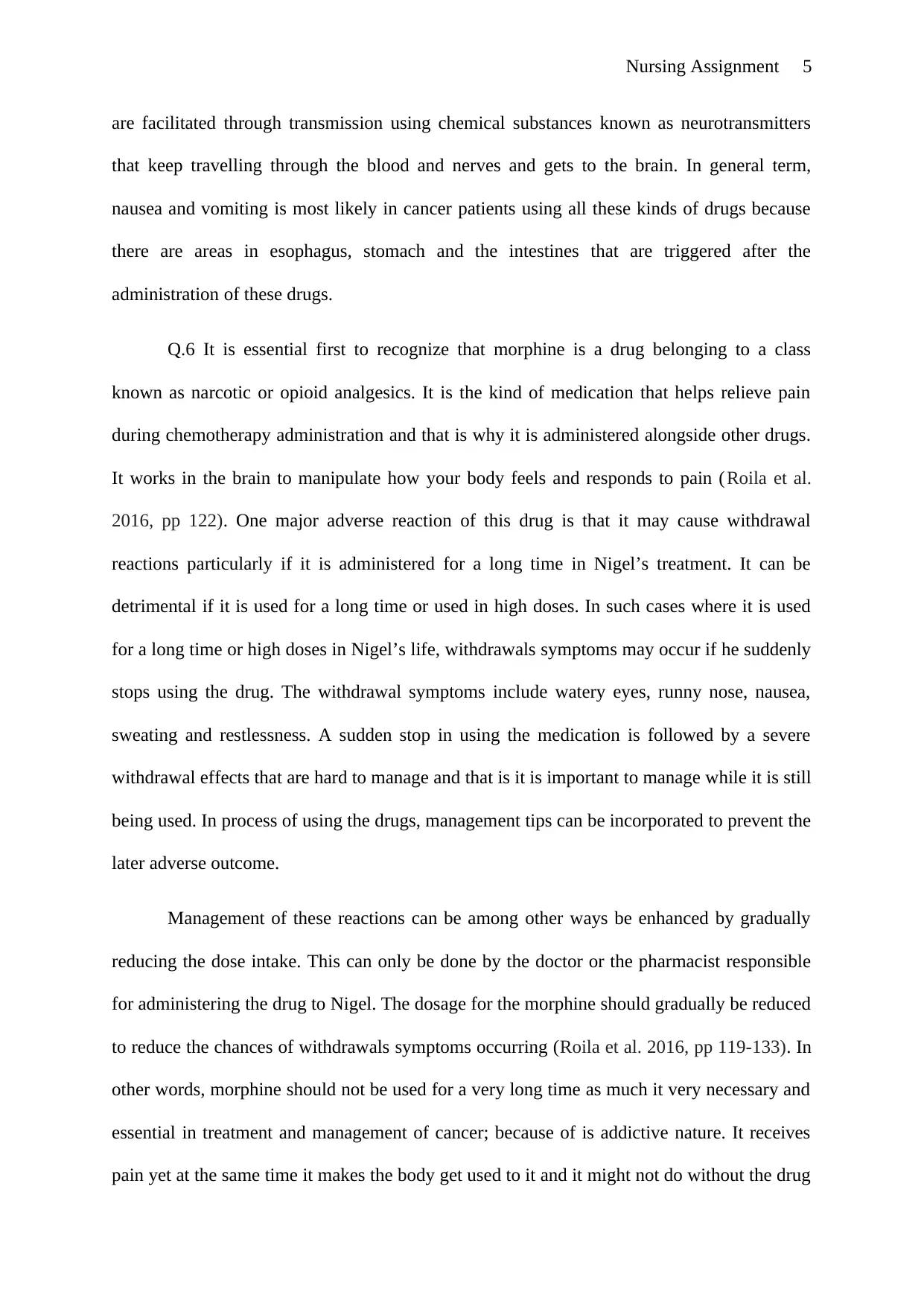NUR231, University Case Study: Analyzing Nigel's Lung Cancer Treatment
VerifiedAdded on 2023/01/20
|7
|2052
|47
Case Study
AI Summary
This case study analyzes the treatment of a 78-year-old male, Nigel, diagnosed with stage 4 non-small cell lung cancer with liver metastases. The assignment discusses the use of docetaxel (chemotherapy), its mechanism of action, and the importance of targeted therapies. It explores the rationale for chemotherapy cycles, maintenance therapy, and the potential use of second-line drugs. The case study also examines the mechanisms of action of different medications, including the comparison between standard chemotherapy and nivolumab (immunotherapy), and the side effects associated with each. Additionally, it addresses the use of morphine for pain management, its adverse reactions, and management strategies to prevent withdrawal symptoms. The assignment provides detailed insights into the patient's condition, treatment plan, and the nursing considerations involved in managing his care.

Nursing Assignment 1
Nursing Assignment
By
Course
Professor
University
City
Date
Nursing Assignment
By
Course
Professor
University
City
Date
Paraphrase This Document
Need a fresh take? Get an instant paraphrase of this document with our AI Paraphraser

Nursing Assignment 2
Q.3 In the case of Nigel, Docetaxel is used to treat his non-small cell lung cancer
stage Docetaxel falls under the group of antineoplastic or cytotoxic medicines (TGA 2018). It
is also known as chemotherapy medicines (TGA 2018). Docetaxel inhibits the growth and
spreading of cancer cells (TGA 2018). Because Nigel’s lung cancer has spread over the
lungs, it will require for a certain uptake of chemotherapy administration for it to be effective.
The kind of the drugs that will be administered to Nigel are those that will inhibit and prevent
growth of the cancerous cells (Gilden et al. 2017, pp 152). The right form of chemotherapy is
the one that will be at the verge of destroying every kind of cancerous cells that tries to rise
itself up. In so doing, it will give Nigel’s body the right lung conditions that he requires for
normal working and operations. Giving room for the growth of these cancerous cells will
result to growth tumors that will eventually pose and cause a risk in loss of life because, one,
the cancerous tumors are at a higher probability of blocking some of the pathways of the lung
that facilitate breathing. This could be the reason why Nigel was experiencing shortness of
breath and difficulty in breathing. It is therefore imperative that the right form of
chemotherapy that he should receive is that one which will call for destroying and breaking
down of the cancer cells and tumors in the lungs to at least enhance normal operation of the
lungs. Nigel’s non-small cancer is widespread all over the lungs, it will call for him to meet a
certain criterion and thus, a targeted therapeutically drugs like necitumumab, bevacizumab
and ramucirumab may be added as well in his treatment apart from his present treatment
medication of cisplatin, Morphine IV, ondansetron and Dexamethasone (Wu et al. 2018, pp
467). He should be given chemo in cycles that follows the period of treatment (is normally 1
to three days) preceded by a period of rest to allow the recovery of the body from the
previous chemo. Some of the chemo drugs, however shoud be administered every day in his
medication. The cycles for this chemo should last roughly about three to four weeks.
Q.3 In the case of Nigel, Docetaxel is used to treat his non-small cell lung cancer
stage Docetaxel falls under the group of antineoplastic or cytotoxic medicines (TGA 2018). It
is also known as chemotherapy medicines (TGA 2018). Docetaxel inhibits the growth and
spreading of cancer cells (TGA 2018). Because Nigel’s lung cancer has spread over the
lungs, it will require for a certain uptake of chemotherapy administration for it to be effective.
The kind of the drugs that will be administered to Nigel are those that will inhibit and prevent
growth of the cancerous cells (Gilden et al. 2017, pp 152). The right form of chemotherapy is
the one that will be at the verge of destroying every kind of cancerous cells that tries to rise
itself up. In so doing, it will give Nigel’s body the right lung conditions that he requires for
normal working and operations. Giving room for the growth of these cancerous cells will
result to growth tumors that will eventually pose and cause a risk in loss of life because, one,
the cancerous tumors are at a higher probability of blocking some of the pathways of the lung
that facilitate breathing. This could be the reason why Nigel was experiencing shortness of
breath and difficulty in breathing. It is therefore imperative that the right form of
chemotherapy that he should receive is that one which will call for destroying and breaking
down of the cancer cells and tumors in the lungs to at least enhance normal operation of the
lungs. Nigel’s non-small cancer is widespread all over the lungs, it will call for him to meet a
certain criterion and thus, a targeted therapeutically drugs like necitumumab, bevacizumab
and ramucirumab may be added as well in his treatment apart from his present treatment
medication of cisplatin, Morphine IV, ondansetron and Dexamethasone (Wu et al. 2018, pp
467). He should be given chemo in cycles that follows the period of treatment (is normally 1
to three days) preceded by a period of rest to allow the recovery of the body from the
previous chemo. Some of the chemo drugs, however shoud be administered every day in his
medication. The cycles for this chemo should last roughly about three to four weeks.

Nursing Assignment 3
Additionally, the initial chemo combination for Nigel should be administered for four to six
cycles. However, it can also be given beyond that period accompanied by a single chemo or a
targeted drug now that Nigel did not have a good response in initial chemotherapy. It is
therefore essential that Nigel be taken trough what we call the maintenance check for the
chemotherapy to effectively work well. The maintenance therapy, will help keep the cancer
in check and facilitate living a long life. And just in case the initial chemo therapy for Nigel
does not completely work, it is essential that a recommendation of the second line drugs
having a single chemo drug like docetaxel or permetrexed, or still accompanied with a
targeted therapy or the immunotherapy drug can be initiated. On average nevertheless, Nigel
would require a single chemo drugs. According to Huang et al. (2017), adding a third chemo
does not add much difference except that it will increase the side effects. Single drug chemo
is most of the time used for people who might not be at a position to tolerate a combination
therapy. Example of such kind of group of people is those who are elderly and in overall poor
general health. For this case, Nigel falls in this category of individuals and therefore it would
be effective for him to be enrolled on a single drug chemo.
Q.4 Mechanism of action of his current medication acts directly on the cancerous
tumors in the lungs and associated parts while the other mechanism of action like using of
nivolumab treats an individual by acting on the immune system. The latter mechanism of
action can both activate a stronger immune response than normal in the body and similarly
teach an individual’s immune system on how to identify and destroy cancer cells. The two
forms of mechanism of action are also different in that the current medication will act by
destroying all the rapidly dividing cells that it locates within the body to destroy the
cancerous tumors. This kind of action may include destroying the normal cells and the
cancerous cells like the hair follicles and the gut lining. The attack of this kind of mechanism
of action is what eventually bring about effects of hair loss and nausea like the ones Nigel is
Additionally, the initial chemo combination for Nigel should be administered for four to six
cycles. However, it can also be given beyond that period accompanied by a single chemo or a
targeted drug now that Nigel did not have a good response in initial chemotherapy. It is
therefore essential that Nigel be taken trough what we call the maintenance check for the
chemotherapy to effectively work well. The maintenance therapy, will help keep the cancer
in check and facilitate living a long life. And just in case the initial chemo therapy for Nigel
does not completely work, it is essential that a recommendation of the second line drugs
having a single chemo drug like docetaxel or permetrexed, or still accompanied with a
targeted therapy or the immunotherapy drug can be initiated. On average nevertheless, Nigel
would require a single chemo drugs. According to Huang et al. (2017), adding a third chemo
does not add much difference except that it will increase the side effects. Single drug chemo
is most of the time used for people who might not be at a position to tolerate a combination
therapy. Example of such kind of group of people is those who are elderly and in overall poor
general health. For this case, Nigel falls in this category of individuals and therefore it would
be effective for him to be enrolled on a single drug chemo.
Q.4 Mechanism of action of his current medication acts directly on the cancerous
tumors in the lungs and associated parts while the other mechanism of action like using of
nivolumab treats an individual by acting on the immune system. The latter mechanism of
action can both activate a stronger immune response than normal in the body and similarly
teach an individual’s immune system on how to identify and destroy cancer cells. The two
forms of mechanism of action are also different in that the current medication will act by
destroying all the rapidly dividing cells that it locates within the body to destroy the
cancerous tumors. This kind of action may include destroying the normal cells and the
cancerous cells like the hair follicles and the gut lining. The attack of this kind of mechanism
of action is what eventually bring about effects of hair loss and nausea like the ones Nigel is
⊘ This is a preview!⊘
Do you want full access?
Subscribe today to unlock all pages.

Trusted by 1+ million students worldwide

Nursing Assignment 4
experiencing. On the contrary, the other mechanism of action involving nivolumab has the
side effects coming from an overactive immune system, and thus it can range from the very
minor inflammation to major conditions that are closely related and looks like the
autoimmune disorders. Other side effects that occur because of the first mechanism includes
diarrhea and rashes, however, these side effects can also occur amongst those using the
second mechanism of action- nivolumab.
The other comparison is based on the length of treatment. Even though it may vary
from patient to patient and affected by different factors specific to persons and the form of
cancer they have, the difference is not that significant. The second mechanism of action may
be given over a defined option of treatments based on the patient responses and whether the
patient is getting treatment as an inclusive part of the clinical trial (Herbst et al 2018, pp 446).
Therefore, for Nigel’s case, this form treatment is not advisable for administration or else it
would mean taking risk. The first mechanism of action was appropriate for him and then the
other second mechanism would come later.
Q.5 Nausea and vomiting are just like every other thing we do every day that are
controlled by the brain. Vomiting itself as one of the side effects of the three drugs is
triggered from the spot found in the brain well known as the vomiting center. There are
various reasons that can prompt the vomiting center to cause an individual to vomit: one,
signals that come from an area of the brain known as the chemoreceptor trigger zone that
normally is very reactive to chemicals and drugs in the blood. two, the signals that come from
the cortex of the brain and the limbic system that becomes reactive to smell, taste, sight and
similarly as the pain and emotions. Three, signals from other areas from other organs and
nerves that give a response to irritation or disease in the organs (Feld et al. 2017, pp 3697). In
chemotherapy for instance such organs are predicted to be found in the esophagus, intestines
and the stomach which are triggered by the medication to cause vomiting. All these signals
experiencing. On the contrary, the other mechanism of action involving nivolumab has the
side effects coming from an overactive immune system, and thus it can range from the very
minor inflammation to major conditions that are closely related and looks like the
autoimmune disorders. Other side effects that occur because of the first mechanism includes
diarrhea and rashes, however, these side effects can also occur amongst those using the
second mechanism of action- nivolumab.
The other comparison is based on the length of treatment. Even though it may vary
from patient to patient and affected by different factors specific to persons and the form of
cancer they have, the difference is not that significant. The second mechanism of action may
be given over a defined option of treatments based on the patient responses and whether the
patient is getting treatment as an inclusive part of the clinical trial (Herbst et al 2018, pp 446).
Therefore, for Nigel’s case, this form treatment is not advisable for administration or else it
would mean taking risk. The first mechanism of action was appropriate for him and then the
other second mechanism would come later.
Q.5 Nausea and vomiting are just like every other thing we do every day that are
controlled by the brain. Vomiting itself as one of the side effects of the three drugs is
triggered from the spot found in the brain well known as the vomiting center. There are
various reasons that can prompt the vomiting center to cause an individual to vomit: one,
signals that come from an area of the brain known as the chemoreceptor trigger zone that
normally is very reactive to chemicals and drugs in the blood. two, the signals that come from
the cortex of the brain and the limbic system that becomes reactive to smell, taste, sight and
similarly as the pain and emotions. Three, signals from other areas from other organs and
nerves that give a response to irritation or disease in the organs (Feld et al. 2017, pp 3697). In
chemotherapy for instance such organs are predicted to be found in the esophagus, intestines
and the stomach which are triggered by the medication to cause vomiting. All these signals
Paraphrase This Document
Need a fresh take? Get an instant paraphrase of this document with our AI Paraphraser

Nursing Assignment 5
are facilitated through transmission using chemical substances known as neurotransmitters
that keep travelling through the blood and nerves and gets to the brain. In general term,
nausea and vomiting is most likely in cancer patients using all these kinds of drugs because
there are areas in esophagus, stomach and the intestines that are triggered after the
administration of these drugs.
Q.6 It is essential first to recognize that morphine is a drug belonging to a class
known as narcotic or opioid analgesics. It is the kind of medication that helps relieve pain
during chemotherapy administration and that is why it is administered alongside other drugs.
It works in the brain to manipulate how your body feels and responds to pain (Roila et al.
2016, pp 122). One major adverse reaction of this drug is that it may cause withdrawal
reactions particularly if it is administered for a long time in Nigel’s treatment. It can be
detrimental if it is used for a long time or used in high doses. In such cases where it is used
for a long time or high doses in Nigel’s life, withdrawals symptoms may occur if he suddenly
stops using the drug. The withdrawal symptoms include watery eyes, runny nose, nausea,
sweating and restlessness. A sudden stop in using the medication is followed by a severe
withdrawal effects that are hard to manage and that is it is important to manage while it is still
being used. In process of using the drugs, management tips can be incorporated to prevent the
later adverse outcome.
Management of these reactions can be among other ways be enhanced by gradually
reducing the dose intake. This can only be done by the doctor or the pharmacist responsible
for administering the drug to Nigel. The dosage for the morphine should gradually be reduced
to reduce the chances of withdrawals symptoms occurring (Roila et al. 2016, pp 119-133). In
other words, morphine should not be used for a very long time as much it very necessary and
essential in treatment and management of cancer; because of is addictive nature. It receives
pain yet at the same time it makes the body get used to it and it might not do without the drug
are facilitated through transmission using chemical substances known as neurotransmitters
that keep travelling through the blood and nerves and gets to the brain. In general term,
nausea and vomiting is most likely in cancer patients using all these kinds of drugs because
there are areas in esophagus, stomach and the intestines that are triggered after the
administration of these drugs.
Q.6 It is essential first to recognize that morphine is a drug belonging to a class
known as narcotic or opioid analgesics. It is the kind of medication that helps relieve pain
during chemotherapy administration and that is why it is administered alongside other drugs.
It works in the brain to manipulate how your body feels and responds to pain (Roila et al.
2016, pp 122). One major adverse reaction of this drug is that it may cause withdrawal
reactions particularly if it is administered for a long time in Nigel’s treatment. It can be
detrimental if it is used for a long time or used in high doses. In such cases where it is used
for a long time or high doses in Nigel’s life, withdrawals symptoms may occur if he suddenly
stops using the drug. The withdrawal symptoms include watery eyes, runny nose, nausea,
sweating and restlessness. A sudden stop in using the medication is followed by a severe
withdrawal effects that are hard to manage and that is it is important to manage while it is still
being used. In process of using the drugs, management tips can be incorporated to prevent the
later adverse outcome.
Management of these reactions can be among other ways be enhanced by gradually
reducing the dose intake. This can only be done by the doctor or the pharmacist responsible
for administering the drug to Nigel. The dosage for the morphine should gradually be reduced
to reduce the chances of withdrawals symptoms occurring (Roila et al. 2016, pp 119-133). In
other words, morphine should not be used for a very long time as much it very necessary and
essential in treatment and management of cancer; because of is addictive nature. It receives
pain yet at the same time it makes the body get used to it and it might not do without the drug

Nursing Assignment 6
some time later in life, it would force Nigel to be using the drug even as he struggles
managing his cancer condition.
References
Feld, E. and Horn, L., 2017. Emerging role of nivolumab in the management of patients with
non-small-cell lung cancer: current data and future perspectives. OncoTargets and
therapy, 10, p.3697.
Gilden, D.M., Kubisiak, J.M., Pohl, G.M., Ball, D.E., Gilden, D.E., John, W.J., Wetmore, S.
and Winfree, K.B., 2017. Treatment patterns and cost-effectiveness of first line
treatment of advanced non-squamous non-small cell lung cancer in Medicare
patients. Journal of medical economics, 20(2), pp.151-161.
Herbst, R.S., Morgensztern, D. and Boshoff, C., 2018. The biology and management of non-
small cell lung cancer. Nature, 553(7689), p.446.
Huang, M., Lou, Y., Pellissier, J., Burke, T., Liu, F.X., Xu, R. and Velcheti, V., 2017. Cost
effectiveness of pembrolizumab vs. standard-of-care chemotherapy as first-line
treatment for metastatic NSCLC that expresses high levels of PD-L1 in the United
States. Pharmacoeconomics, 35(8), pp.831-844.
Roila, F., Molassiotis, A., Herrstedt, J., Aapro, M., Gralla, R.J., Bruera, E., Clark-Snow,
R.A., Dupuis, L.L., Einhorn, L.H., Feyer, P. and Hesketh, P.J., 2016. 2016
MASCC and ESMO guideline update for the prevention of chemotherapy-and
radiotherapy-induced nausea and vomiting and of nausea and vomiting in advanced
cancer patients. Annals of Oncology, 27(suppl_5), pp.v119-v133.
Wu, Y.L., Sequist, L.V., Tan, E.H., Geater, S.L., Orlov, S., Zhang, L., Lee, K.H., Tsai, C.M.,
Kato, T., Barrios, C.H. and Schuler, M., 2018. Afatinib as first-line treatment of
some time later in life, it would force Nigel to be using the drug even as he struggles
managing his cancer condition.
References
Feld, E. and Horn, L., 2017. Emerging role of nivolumab in the management of patients with
non-small-cell lung cancer: current data and future perspectives. OncoTargets and
therapy, 10, p.3697.
Gilden, D.M., Kubisiak, J.M., Pohl, G.M., Ball, D.E., Gilden, D.E., John, W.J., Wetmore, S.
and Winfree, K.B., 2017. Treatment patterns and cost-effectiveness of first line
treatment of advanced non-squamous non-small cell lung cancer in Medicare
patients. Journal of medical economics, 20(2), pp.151-161.
Herbst, R.S., Morgensztern, D. and Boshoff, C., 2018. The biology and management of non-
small cell lung cancer. Nature, 553(7689), p.446.
Huang, M., Lou, Y., Pellissier, J., Burke, T., Liu, F.X., Xu, R. and Velcheti, V., 2017. Cost
effectiveness of pembrolizumab vs. standard-of-care chemotherapy as first-line
treatment for metastatic NSCLC that expresses high levels of PD-L1 in the United
States. Pharmacoeconomics, 35(8), pp.831-844.
Roila, F., Molassiotis, A., Herrstedt, J., Aapro, M., Gralla, R.J., Bruera, E., Clark-Snow,
R.A., Dupuis, L.L., Einhorn, L.H., Feyer, P. and Hesketh, P.J., 2016. 2016
MASCC and ESMO guideline update for the prevention of chemotherapy-and
radiotherapy-induced nausea and vomiting and of nausea and vomiting in advanced
cancer patients. Annals of Oncology, 27(suppl_5), pp.v119-v133.
Wu, Y.L., Sequist, L.V., Tan, E.H., Geater, S.L., Orlov, S., Zhang, L., Lee, K.H., Tsai, C.M.,
Kato, T., Barrios, C.H. and Schuler, M., 2018. Afatinib as first-line treatment of
⊘ This is a preview!⊘
Do you want full access?
Subscribe today to unlock all pages.

Trusted by 1+ million students worldwide

Nursing Assignment 7
older patients with EGFR mutation-positive non-small-cell lung cancer: subgroup
analyses of the LUX-Lung 3, LUX-Lung 6, and LUX-Lung 7 trials. Clinical lung
cancer, 19(4), pp.e465-e479.
older patients with EGFR mutation-positive non-small-cell lung cancer: subgroup
analyses of the LUX-Lung 3, LUX-Lung 6, and LUX-Lung 7 trials. Clinical lung
cancer, 19(4), pp.e465-e479.
1 out of 7
Related Documents
Your All-in-One AI-Powered Toolkit for Academic Success.
+13062052269
info@desklib.com
Available 24*7 on WhatsApp / Email
![[object Object]](/_next/static/media/star-bottom.7253800d.svg)
Unlock your academic potential
Copyright © 2020–2025 A2Z Services. All Rights Reserved. Developed and managed by ZUCOL.




